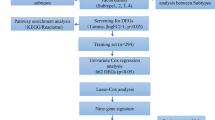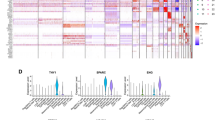Abstract
Purpose
Cancer stem cells are associated with unfavorable prognosis in hepatocellular carcinoma (HCC). However, existing stemness-related biomarkers and prognostic models are limited.
Methods
The stemness-related signatures were derived from taking the union of the results obtained by performing WGCNA and CytoTRACE analysis at the bulk RNA-seq and scRNA-seq levels, respectively. Univariate Cox regression and the LASSO were applied for filtering prognosis-related signatures and selecting variables. Finally, ten gene signatures were identified to construct the prognostic model. We evaluated the differences in survival, genomic alternation, biological processes, and degree of immune cell infiltration in the high- and low-risk groups. pRRophetic and Tumor Immune Dysfunction and Exclusion (TIDE) algorithms were utilized to predict chemosensitivity and immunotherapy response. Human Protein Atlas (HPA) database was used to evaluate the protein expressions.
Results
A stemness-related prognostic model was constructed with ten genes including YBX1, CYB5R3, CDC20, RAMP3, LDHA, MTHFS, PTRH2, SRPRB, GNA14, and CLEC3B. Kaplan–Meier and ROC curve analyses showed that the high-risk group had a worse prognosis and the AUC of the model in four datasets was greater than 0.64. Multivariate Cox regression analyses verified that the model was an independent prognostic indicator in predicting overall survival, and a nomogram was then built for clinical utility in predicting the prognosis of HCC. Additionally, chemotherapy drug sensitivity and immunotherapy response analyses revealed that the high-risk group exhibited a higher likelihood of benefiting from these treatments.
Conclusion
The novel stemness-related prognostic model is a promising biomarker for estimating overall survival in HCC.








Similar content being viewed by others
Data availability
The data used to support the findings of this study are available from the corresponding author upon request.
References
Aibar S, Gonzalez-Blas CB, Moerman T, Huynh-Thu VA, Imrichova H, Hulselmans G et al (2017) SCENIC: single-cell regulatory network inference and clustering. Nat Methods 14(11):1083–1086. https://doi.org/10.1038/nmeth.4463
Aran D, Looney AP, Liu L, Wu E, Fong V, Hsu A et al (2019) Reference-based analysis of lung single-cell sequencing reveals a transitional profibrotic macrophage. Nat Immunol 20(2):163–172. https://doi.org/10.1038/s41590-018-0276-y
Becht E, McInnes L, Healy J, Dutertre CA, Kwok IWH, Ng LG et al (2018) Dimensionality reduction for visualizing single-cell data using UMAP. Nat Biotechnol. https://doi.org/10.1038/nbt.4314
Ben-Porath I, Thomson MW, Carey VJ, Ge R, Bell GW, Regev A et al (2008) An embryonic stem cell-like gene expression signature in poorly differentiated aggressive human tumors. Nat Genet 40(5):499–507. https://doi.org/10.1038/ng.127
Bykov VJN, Eriksson SE, Bianchi J, Wiman KG (2018) Targeting mutant p53 for efficient cancer therapy. Nat Rev Cancer 18(2):89–102. https://doi.org/10.1038/nrc.2017.109
Chen K, Huang YH, Chen JL (2013) Understanding and targeting cancer stem cells: therapeutic implications and challenges. Acta Pharmacol Sin 34(6):732–740. https://doi.org/10.1038/aps.2013.27
Chen K, Liu X, Liu W, Wang F, Tian X, Yang Y (2022) Development and validation of prognostic and diagnostic model for pancreatic ductal adenocarcinoma based on scRNA-seq and bulk-seq datasets. Hum Mol Genet 31(10):1705–1719. https://doi.org/10.1093/hmg/ddab343
Corpuz AD, Ramos JW, Matter ML (2020) PTRH2: an adhesion regulated molecular switch at the nexus of life, death, and differentiation. Cell Death Discov 6(1):124. https://doi.org/10.1038/s41420-020-00357-0
Dai W, Wang Y, Yang T, Wang J, Wu W, Gu J (2019) Downregulation of exosomal CLEC3B in hepatocellular carcinoma promotes metastasis and angiogenesis via AMPK and VEGF signals. Cell Commun Signal 17(1):113. https://doi.org/10.1186/s12964-019-0423-6
Fang A, Zhou S, Su X, Liu C, Chen X, Wan Y et al (2018) RAMP3 is a prognostic indicator of liver cancer and might reduce the adverse effect of TP53 mutation on survival. Future Oncol 14(25):2615–2625. https://doi.org/10.2217/fon-2018-0296
Forner A, Reig M, Bruix J (2018) Hepatocellular carcinoma. Lancet 391(10127):1301–1314. https://doi.org/10.1016/s0140-6736(18)30010-2
Gao Q, Zhu H, Dong L, Shi W, Chen R, Song Z et al (2019) Integrated proteogenomic characterization of HBV-related hepatocellular carcinoma. Cell 179(2):561-577.e22. https://doi.org/10.1016/j.cell.2019.08.052
Grasso CS, Tsoi J, Onyshchenko M, Abril-Rodriguez G, Ross-Macdonald P, Wind-Rotolo M et al (2020) Conserved interferon-γ signaling drives clinical response to immune checkpoint blockade therapy in melanoma. Cancer Cell 38(4):500-515.e3. https://doi.org/10.1016/j.ccell.2020.08.005
Gulati GS, Sikandar SS, Wesche DJ, Manjunath A, Bharadwaj A, Berger MJ et al (2020) Single-cell transcriptional diversity is a hallmark of developmental potential. Science 367(6476):405–411. https://doi.org/10.1126/science.aax0249
Heagerty PJ, Zheng Y (2005) Survival model predictive accuracy and ROC curves. Biometrics 61(1):92–105. https://doi.org/10.1111/j.0006-341X.2005.030814.x
Jeong SM, Bui QT, Kwak M, Lee JY, Lee PC (2022) Targeting Cdc20 for cancer therapy. Biochim Biophys Acta Rev Cancer 1877(6):188824. https://doi.org/10.1016/j.bbcan.2022.188824
Jin S, Guerrero-Juarez CF, Zhang L, Chang I, Ramos R, Kuan CH et al (2021) Inference and analysis of cell-cell communication using Cell Chat. Nat Commun 12(1):1088. https://doi.org/10.1038/s41467-021-21246-9
Langfelder P, Horvath S (2008) WGCNA: an R package for weighted correlation network analysis. BMC Bioinformatics 9:559. https://doi.org/10.1186/1471-2105-9-559
Lee TK, Guan XY, Ma S (2022) Cancer stem cells in hepatocellular carcinoma-from origin to clinical implications. Nat Rev Gastroenterol Hepatol 19(1):26–44. https://doi.org/10.1038/s41575-021-00508-3
Li X, Li Y, Yu X, Jin F (2020) Identification and validation of stemness-related lncRNA prognostic signature for breast cancer. J Transl Med 18(1):331. https://doi.org/10.1186/s12967-020-02497-4
Li X, Ramadori P, Pfister D, Seehawer M, Zender L, Heikenwalder M (2021) The immunological and metabolic landscape in primary and metastatic liver cancer. Nat Rev Cancer 21(9):541–557. https://doi.org/10.1038/s41568-021-00383-9
Malta TM, Sokolov A, Gentles AJ, Burzykowski T, Poisson L, Weinstein JN et al (2018) Machine learning identifies stemness features associated with oncogenic dedifferentiation. Cell 173(2):338-354e15. https://doi.org/10.1016/j.cell.2018.03.034
Miranda A, Hamilton PT, Zhang AW, Pattnaik S, Becht E, Mezheyeuski A et al (2019) Cancer stemness, intratumoral heterogeneity, and immune response across cancers. Proc Natl Acad Sci USA 116(18):9020–9029. https://doi.org/10.1073/pnas.1818210116
Newman AM, Steen CB, Liu CL, Gentles AJ, Chaudhuri AA, Scherer F et al (2019) Determining cell type abundance and expression from bulk tissues with digital cytometry. Nat Biotechnol 37(7):773–782. https://doi.org/10.1038/s41587-019-0114-2
Qiu X, Mao Q, Tang Y, Wang L, Chawla R, Pliner HA et al (2017) Reversed graph embedding resolves complex single-cell trajectories. Nat Methods 14(10):979–982. https://doi.org/10.1038/nmeth.4402
Ritchie ME, Phipson B, Wu D, Hu Y, Law CW, Shi W et al (2015) Limma powers differential expression analyses for RNA-sequencing and microarray studies. Nucleic Acids Res 43(7):e47. https://doi.org/10.1093/nar/gkv007
Serra M, Di Matteo M, Serneels J, Pal R, Cafarello ST, Lanza M et al (2022) Deletion of lactate dehydrogenase-A impairs oncogene-induced mouse hepatocellular carcinoma development. Cell Mol Gastroenterol Hepatol 14(3):609–624. https://doi.org/10.1016/j.jcmgh.2022.06.003
Song G, Zhu X, Xuan Z, Zhao L, Dong H, Chen J et al (2021) Hypermethylation of GNA14 and its tumor-suppressive role in hepatitis B virus-related hepatocellular carcinoma. Theranostics 11(5):2318–2333. https://doi.org/10.7150/thno.48739
Song P, Li W, Wu X, Qian Z, Ying J, Gao S et al (2022) Integrated analysis of single-cell and bulk RNA-sequencing identifies a signature based on B cell marker genes to predict prognosis and immunotherapy response in lung adenocarcinoma. Cancer Immunol Immunother 71(10):2341–2354. https://doi.org/10.1007/s00262-022-03143-2
Sun D, Guan X, Moran AE, Wu LY, Qian DZ, Schedin P et al (2022) Identifying phenotype-associated subpopulations by integrating bulk and single-cell sequencing data. Nat Biotechnol 40(4):527–538. https://doi.org/10.1038/s41587-021-01091-3
Takashima Y, Horisawa K, Udono M, Ohkawa Y, Suzuki A (2018) Prolonged inhibition of hepatocellular carcinoma cell proliferation by combinatorial expression of defined transcription factors. Cancer Sci 109(11):3543–3553. https://doi.org/10.1111/cas.13798
Tao Z, Ruan H, Sun L, Kuang D, Song Y, Wang Q et al (2019) Targeting the YB-1/PD-L1 axis to enhance chemotherapy and antitumor immunity. Cancer Immunol Res 7(7):1135–1147. https://doi.org/10.1158/2326-6066.CIR-18-0648
Thorgeirsson SS, Lee JS, Grisham JW (2006) Functional genomics of hepatocellular carcinoma. Hepatology 43(2 Suppl 1):S145–S150. https://doi.org/10.1002/hep.21063
Tibshirani R (1997) The lasso method for variable selection in the Cox model. Stat Med 16(4):385–395
Wang R, Zheng X, Wang J, Wan S, Song F, Wong MH et al (2022) Improving bulk RNA-seq classification by transferring gene signature from single cells in acute myeloid leukemia. Brief Bioinform. https://doi.org/10.1093/bib/bbac002
Weng M, Li T, Zhao J, Guo M, Zhao W, Gu W et al (2022) mRNAsi-related metabolic risk score model identifies poor prognosis, immunoevasive contexture, and low chemotherapy response in colorectal cancer patients through machine learning. Front Immunol 13:950782. https://doi.org/10.3389/fimmu.2022.950782
Weston AD, Hood L (2004) Systems biology, proteomics, and the future of health care: toward predictive, preventative, and personalized medicine. J Proteome Res 3(2):179–196. https://doi.org/10.1021/pr0499693
Xu J, Ji L, Liang Y, Wan Z, Zheng W, Song X et al (2020) CircRNA-SORE mediates sorafenib resistance in hepatocellular carcinoma by stabilizing YBX1. Signal Transduct Target Ther 5(1):298. https://doi.org/10.1038/s41392-020-00375-5
Yamashita T, Wang XW (2013) Cancer stem cells in the development of liver cancer. J Clin Invest 123(5):1911–1918. https://doi.org/10.1172/JCI66024
Yue Y, Tao J, An D, Shi L (2022) Exploring the role of tumor stemness and the potential of stemness-related risk model in the prognosis of intrahepatic cholangiocarcinoma. Front Genet 13:1089405. https://doi.org/10.3389/fgene.2022.1089405
Zheng L, Xu M, Xu J, Wu K, Fang Q, Liang Y et al (2018) ELF3 promotes epithelial-mesenchymal transition by protecting ZEB1 from miR-141–3p-mediated silencing in hepatocellular carcinoma. Cell Death Dis 9(3):387. https://doi.org/10.1038/s41419-018-0399-y
Zhu L, Liu J, Chen J, Zhou Q (2021) The developing landscape of combinatorial therapies of immune checkpoint blockade with DNA damage repair inhibitors for the treatment of breast and ovarian cancers. J Hematol Oncol 14(1):206. https://doi.org/10.1186/s13045-021-01218-8
Funding
National Natural Science Foundation of China [No.81973145, No. 82273735]. Key R&D Program of Jiangsu Province (Social Development) (BE2020694).
Author information
Authors and Affiliations
Contributions
XW, XC: methodology, data curation, formal analysis, writing—original draft preparation. MZ, GL, and DC: validation and formal analysis; JF and FY: conceptualization, writing—review and editing. All authors have read and agreed to the published version of the manuscript.
Corresponding authors
Ethics declarations
Conflict of interest
The authors have no relevant financial or non-financial interests to disclose.
Additional information
Publisher's Note
Springer Nature remains neutral with regard to jurisdictional claims in published maps and institutional affiliations.
Supplementary Information
Below is the link to the electronic supplementary material.
Rights and permissions
Springer Nature or its licensor (e.g. a society or other partner) holds exclusive rights to this article under a publishing agreement with the author(s) or other rightsholder(s); author self-archiving of the accepted manuscript version of this article is solely governed by the terms of such publishing agreement and applicable law.
About this article
Cite this article
Wang, X., Chen, X., Zhao, M. et al. Integration of scRNA-seq and bulk RNA-seq constructs a stemness-related signature for predicting prognosis and immunotherapy responses in hepatocellular carcinoma. J Cancer Res Clin Oncol 149, 13823–13839 (2023). https://doi.org/10.1007/s00432-023-05202-2
Received:
Accepted:
Published:
Issue Date:
DOI: https://doi.org/10.1007/s00432-023-05202-2




